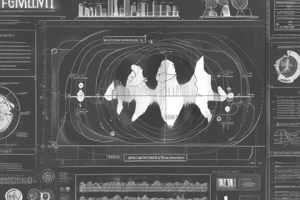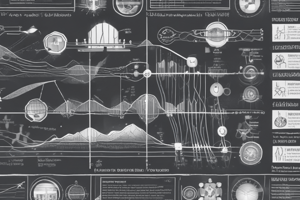Podcast
Questions and Answers
What is the primary purpose of using bar graphs in biological studies?
What is the primary purpose of using bar graphs in biological studies?
- To illustrate proportions of a whole
- To compare different groups or categories (correct)
- To display relationships between quantitative variables
- To show changes over time
Which type of graph is best for illustrating trends over time?
Which type of graph is best for illustrating trends over time?
- Bar Graph
- Scatter Plot
- Pie Chart
- Line Graph (correct)
In a scatter plot, what type of variables does it display?
In a scatter plot, what type of variables does it display?
- Single quantitative variable
- Categorical variables
- Dependent and independent variables (correct)
- Qualitative data
What does a pie chart represent in data interpretation?
What does a pie chart represent in data interpretation?
Which statistical measure is NOT typically used to understand central tendency?
Which statistical measure is NOT typically used to understand central tendency?
When interpreting graphs, what should you primarily look for?
When interpreting graphs, what should you primarily look for?
Creating appropriate graphs involves which of the following?
Creating appropriate graphs involves which of the following?
In experimental design, what is a control group used for?
In experimental design, what is a control group used for?
Which strategy is NOT recommended for success in graph and data-related questions?
Which strategy is NOT recommended for success in graph and data-related questions?
What would you typically look for when comparing multiple graphs?
What would you typically look for when comparing multiple graphs?
Flashcards are hidden until you start studying
Study Notes
Biology: Standardized Test Practice with Graphs and Data
Importance of Graphs and Data in Biology
- Visual representation of data enhances understanding of biological concepts.
- Graphs help in identifying trends, patterns, and relationships in biological data.
Common Types of Graphs
-
Bar Graphs
- Used to compare different groups or categories.
- Useful for displaying categorical data.
-
Line Graphs
- Ideal for showing changes over time or continuous data.
- Helps in illustrating trends and relationships.
-
Scatter Plots
- Display the relationship between two quantitative variables.
- Useful for identifying correlations.
-
Pie Charts
- Represent proportions of a whole.
- Useful for showing relative percentages.
Key Concepts in Data Interpretation
-
Axes and Labels
- X-axis: Independent variable.
- Y-axis: Dependent variable.
- Clear labeling is crucial for understanding.
-
Trends and Patterns
- Look for increases, decreases, or constants in data.
- Identify any outliers or anomalies.
-
Statistical Measures
- Mean, median, mode for central tendency.
- Range and standard deviation for variability.
Practice Strategies
-
Review Sample Graphs
- Analyze different types of graphs often seen in exams.
- Practice interpreting data from graphs.
-
Practice Questions
- Answer questions related to reading graphs and data sets.
- Focus on application of knowledge in hypothetical scenarios.
-
Create Your Own Graphs
- Use collected data to create various graph types.
- Practice labeling and explaining the significance of your graphs.
-
Understand Experimental Design
- Familiarity with control and experimental groups.
- Importance of variables and their management in experiments.
Common Graph-Related Questions in Biology Exams
-
Data Interpretation
- Identify trends or patterns from provided graphs.
- Answer questions based on graph data.
-
Graph Creation
- Given data, construct an appropriate graph.
- Label axes and explain what the graph represents.
-
Comparative Analysis
- Compare data from multiple graphs to draw conclusions.
-
Predictive Questions
- Make predictions based on observed trends from graphs.
Tips for Success
- Regularly practice with graphs and data-related questions.
- Familiarize yourself with biological terminology used in graphs.
- Use study aids and tools to visualize complex data.
- Time yourself while practicing to simulate test conditions.
Importance of Graphs and Data in Biology
- Visual data representation aids comprehension of biological concepts.
- Graphs reveal trends, patterns, and relationships in biological research.
Common Types of Graphs
- Bar Graphs
- Compare different groups or categories, suitable for categorical data.
- Line Graphs
- Show changes over time or continuous data, effective for illustrating trends.
- Scatter Plots
- Illustrate relationships between two quantitative variables, helpful for identifying correlations.
- Pie Charts
- Display proportions of a whole, effective for showing relative percentages.
Key Concepts in Data Interpretation
- Axes and Labels
- X-axis represents the independent variable; Y-axis represents the dependent variable.
- Clear labeling is essential for effective understanding.
- Trends and Patterns
- Monitor for increases, decreases, or constancy in data.
- Identify outliers or anomalies that may affect interpretation.
- Statistical Measures
- Measure central tendency with mean, median, and mode.
- Understand variability through range and standard deviation.
Practice Strategies
- Review Sample Graphs
- Regular analysis of types often featured in exams.
- Develop skills in interpreting data presented in graphical format.
- Practice Questions
- Engage in questions relating to graph reading and data sets.
- Apply knowledge in hypothetical scenarios to enhance understanding.
- Create Your Own Graphs
- Collect and utilize data to construct various graph types.
- Label graphs accurately and explain their significance.
- Understand Experimental Design
- Familiarize with control and experimental group dynamics.
- Understand the management of variables in experiments.
Common Graph-Related Questions in Biology Exams
- Data Interpretation
- Identify trends or patterns based on provided graphs.
- Answer questions based on the data presented in the graphs.
- Graph Creation
- Construct appropriate graphs from given data.
- Ensure axes are labeled and explain the graph's representation.
- Comparative Analysis
- Compare data from multiple graphs to derive conclusions.
- Predictive Questions
- Make predictions based on observable trends in graphs.
Tips for Success
- Engage in regular practice with graph and data-related questions.
- Familiarize with biological terminology relevant to graph interpretations.
- Utilize study aids and visualization tools for complex data comprehension.
- Practice time management by simulating test conditions during practice sessions.
Studying That Suits You
Use AI to generate personalized quizzes and flashcards to suit your learning preferences.




